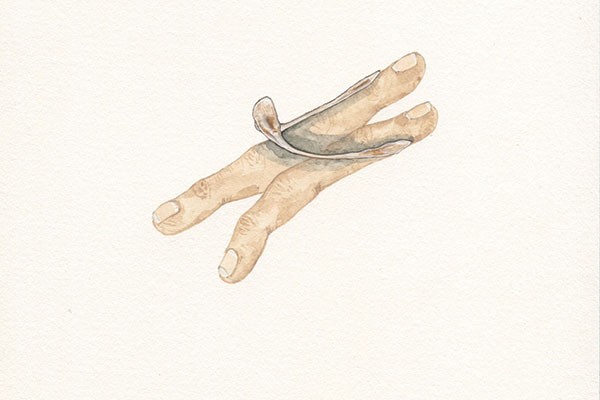Inside the Dunedin Public Art Gallery is an aesthetically pleasing corner that contains all the luck you need. Covered in white tiles and created with a heavenly balanced composition, sits Zina Swanson’s exhibition, For Luck. It is meticulous and precise, a goldmine for those with OCD.
Swanson hails from Christchurch, where she completed a major in sculpture in 2003 at the University of Canterbury School of Fine Arts. Her works have been exhibited all over New Zealand, and internationally in such places as New York. Often her works unite the natural world with the unnatural and provide a critique on how humans objectify the life around them.
The exhibition consists of five paintings of “lucky” iconography evenly aligned on one wall, wishbones caught in a net with glass jars of oil hanging from each corner in the centre of another wall, and a platform that accommodates smaller sculptures. Swanson’s work focuses on the symbols and iconography of luck. From wishbones, dandelions and eyelashes to four-leaf clovers, groups of threes and acorns in pockets. This work combines the natural world and our material world — like the live bamboo that grows out of holes in the tiles, a four-leaf clover that sits in a drain, and a hair net containing New Zealand thistleweed (aka, fairies). Swanson evokes a sense of calm and naivety with undertones of possession and control.
Each of the five paintings illustrates interactions between humans and symbols of luck in nature. One painting has the artist’s eyelashes stuck to it (when one finds an eyelash, they blow it from their finger and make a wish). Another is a depiction of an acorn in a pocket (considered good luck in United Kingdom). The other paintings are a fragile rendition of two hands reaching for a magic wand, a wishbone that merges with crossed fingers, and a blue palm print with the fingers capped with green tops. It is hard not to feel nostalgic when looking at the simplistic depictions of luck and magic. There is a sense of innocence in Swanson’s delicate pastel and watercolour paintings that contrasts with the probing and sterile feel of the tiled setting.
But a darker meaning underlies the pleasant aesthetic of the space: possession. Sure, the paintings have charming “lucky” features, but each of these features has been obtained and collected. Although there is a strange beauty in wishbones caught in a net or dandelions positioned innocently under a glass cover, they are caught and claimed. The plants are juxtaposed in the simplistic bathroom scape. They are incompatible. They have been taken. The three stalks of bamboo do not grow in their natural environment — they have been possessed. One of the framed paintings carries a trace of the artist’s hand with about 100 of her eyelashes within circles. Swanson has meticulously and ritualistically collected her own eyelashes.
These features play on ideas of containment and ownership, but also reliance. The items do not naturally belong in a bathroom setting; they have all been drawn here by the artist. They are innocently collected, and these symbols have been ritualised in our culture. These otherwise inanimate objects have had value placed on them; they now have a meaning. In turn this gives the viewers, who are in the position of placing value, a certain power. But the objects are vessels for projection. So who or what really has the power? Perhaps the innocence in collecting lucky trinkets excuses the ignorance.
For Luck is a very reflexive work — it remarks on the value and meaning we give to inanimate objects. These lucky charms have been caught, but have not been emptied of their luck yet. They are anticipating use and are presented fully loaded with charm.



